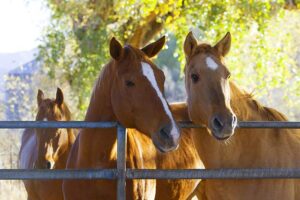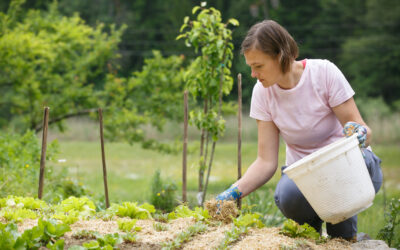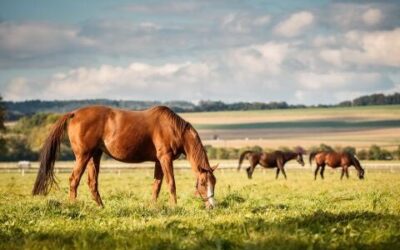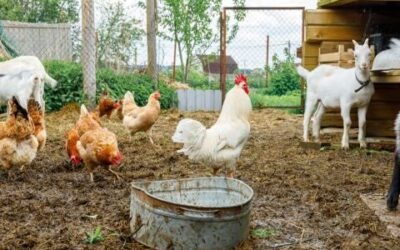Selenium’s Role in the Equine Diet…PLUS: New Data Shows Link to Cribbing
 In a recent conversation between Lucerne Farms and Scot Tolman of Shooting Star Farm, Tolman lamented his region’s lack of selenium in the soil that resulted in a deficiency in his horses’ diet. Tolman’s interest in the mineral was in large part a result of his role as a breeder – the lack of selenium in his mares’ diet had an observable impact on their fertility.
In a recent conversation between Lucerne Farms and Scot Tolman of Shooting Star Farm, Tolman lamented his region’s lack of selenium in the soil that resulted in a deficiency in his horses’ diet. Tolman’s interest in the mineral was in large part a result of his role as a breeder – the lack of selenium in his mares’ diet had an observable impact on their fertility.
We wanted to take a closer look at this mineral, its role in equine nutrition, and what steps owners can take to achieve the proper balance in their horse’s diet.
What is Selenium?
Selenium’s primary role in the body is that of antioxidant. It plays a role in thyroid hormone activation and is well-known for its role as a muscle protein, which is why deficiency can present as muscular degeneration in horses. Selenium is also necessary for the development of the acquired immune system and, because it is important to cellular growth, it may play a role in preventing cancer.
Selenium is often discussed in relation to vitamin E; both are antioxidants and their functions are linked. For example, levels of one can offset deficiency in the other. According to TheHorse.com, inadequate amounts of either vitamin E or selenium result in increased oxidation-induced damage and therefore similar effects of deficiency.
Find out more about Selenium and the Equine Diet at TheHorse.com.
Soil & Selenium
 Shooting Star Farm is located in the Northeast, an area known for low levels of selenium. In fact, many regions with high horse populations in the U.S. – some regions of Florida, for example – have selenium-deficient soils. This results in selenium-deficient forage, something that can certainly affect the grazing horse. In other regions, Colorado and New Mexico, selenium levels are high, and toxicity, not deficiency, is the primary concern.
Shooting Star Farm is located in the Northeast, an area known for low levels of selenium. In fact, many regions with high horse populations in the U.S. – some regions of Florida, for example – have selenium-deficient soils. This results in selenium-deficient forage, something that can certainly affect the grazing horse. In other regions, Colorado and New Mexico, selenium levels are high, and toxicity, not deficiency, is the primary concern.
Depending on your state, a state-specific map may also be available to understand the trace minerals in your region.
Too Much
Historically, selenium has been known as a mineral associated with a red alert because of the danger of toxicity and possible death for horses. These cautions are warranted: selenium has a very narrow range of nutritional safety. While adequate levels are important, selenium that exceeds the healthy range, which can be 1-3 mg per day for a 1100 lb. horse and range from 3-5 mg for athletes, can lead to toxicity. Signs of toxicity can include hair loss, sloughing of hooves, and joint issues that cause lameness. Other effects include liver damage, heart damage, muscle damage and bone degeneration, and eventually death.
Not Enough
Signs of selenium deficiency can be easily missed. Selenium works on the oxidative defense system, and initial effects present below the surface, affecting cellular integrity. When symptoms do emerge, they can include poor hair and coat, hoof issues such as chipping and cracking, work intolerance, muscle disease and weakness, cardiomyopathy. And, as Tolman has noted anecdotally, low levels of selenium can cause reproductive failure, a link corroborated by some studies.
Because selenium and vitamin E is well known as a preventative for muscle disorders, selenium deficiency has also been identified as a factor in cases of “tying-up,” a syndrome characterized by intense contraction, or cramping, of the horse’s muscles. Today, selenium is added as a supplement to most commercial grains, making this concern much less common.
Cribbing & Selenium: New Data
Cribbing, a behavioral pattern termed “stereotypic behavior,” involves biting a fence or stall door, for example, accompanied by a sharp intake of air and a grunting noise. Stall-walking and weaving can accompany cribbing as part of these behaviors. While cribbing has often been associated with boredom and stress, recent research suggests a link between cribbing and selenium, suggesting cribbing may be related to increased oxidative stress and alternations in essential trace elements such as selenium, zinc, manganese, and copper.
Read more about Possible Link Between Selenium and Cribbing in Horses from Kentucky Equine Research, released in April.
Selenium Safety – The Bottom Line
Horse owners concerned about safe and healthy levels of selenium should follow these recommendations:
- Have a blood test to evaluate selenium levels in your horse.
- Test your horse’s forage by sending a sample to a testing a lab or contact your local county extension service – they may offer analysis services or provide analysis.
- Keep in mind the small difference between selenium requirements and toxicity levels. Work with your vet or equine nutritionist to formulate a plan based on your data to ensure your horse is getting optimum levels in his diet.




